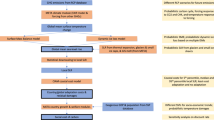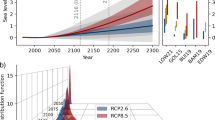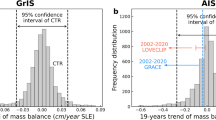Abstract
Uncertainty in future CO2 emissions and the geophysical response to emissions drives variability in future sea-level rise. However, the relative contributions of emissions and geophysical dynamics (for example, Antarctic Ice Sheet (AIS) tipping points) to future sea-level projections are not well understood. Here we disentangle their relative importance by propagating an ensemble of CO2 emissions trajectories through a calibrated carbon cycle–climate–sea-level model chain. Without negative emissions, the CO2 emissions trajectory, particularly the timing of when emissions are reduced, becomes the primary driver of sea-level variability between 2065 and 2075. Accelerated AIS melting greatly influences the sensitivity of global mean sea-level rise to time-averaged and integrated temperature changes. The most important geophysical uncertainties associated with the risk of exceeding sea-level thresholds are the threshold corresponding to accelerated AIS melting and equilibrium climate sensitivity. Our results highlight the need for both adaptation and rapid decarbonization to manage the risks posed by SLR.
This is a preview of subscription content, access via your institution
Access options
Access Nature and 54 other Nature Portfolio journals
Get Nature+, our best-value online-access subscription
$32.99 / 30 days
cancel any time
Subscribe to this journal
Receive 12 print issues and online access
$259.00 per year
only $21.58 per issue
Buy this article
- Purchase on SpringerLink
- Instant access to full article PDF
Prices may be subject to local taxes which are calculated during checkout




Similar content being viewed by others
Data availability
All input data used for the analysis are available with the code (in the data folder) except for the SNEASY–BRICK calibration results, which available from Zenodo via https://doi.org/10.5281/zenodo.6626335 (ref. 62) (see the GitHub README for guidance on which file to use). Simulation outputs from this experiment are available from Zenodo via https://doi.org/10.5281/zenodo.10373089 (ref. 63). Outputs for BRICK when forced by the Shared Socioeconomic Pathways are available from Zenodo via https://doi.org/10.5281/zenodo.14346558 (ref. 64).
Code availability
All code used for this analysis is available from Zenodo via https://doi.org/10.5281/zenodo.10391373 (ref. 65). This code is available under a GNU General Public License v.3.0.
References
Ricke, K. L. & Caldeira, K. Maximum warming occurs about one decade after a carbon dioxide emission. Environ. Res. Lett. 9, 124002 (2014).
Keller, K., Helgeson, C. & Srikrishnan, V. Climate risk management. Annu. Rev. Earth Planet. Sci. 49, 95–116 (2021).
Milillo, P. et al. Heterogeneous retreat and ice melt of Thwaites Glacier, West Antarctica. Sci. Adv. 5, eaau3433 (2019).
Alley, K. E. et al. Two decades of dynamic change and progressive destabilization on the Thwaites Eastern Ice Shelf. Cryosphere 15, 5187–5203 (2021).
Miles, B. W. J. et al. Intermittent structural weakening and acceleration of the Thwaites Glacier Tongue between 2000 and 2018. J. Glaciol. 66, 485–495 (2020).
Nöel, B. et al. Higher Antarctic ice sheet accumulation and surface melt rates revealed at 2 km resolution. Nat. Commun. 14, 1–11 (2023).
Millan, R. et al. Rapid disintegration and weakening of ice shelves in North Greenland. Nat. Commun. 14, 6914 (2023).
Choi, Y., Morlighem, M., Rignot, E. & Wood, M. Ice dynamics will remain a primary driver of Greenland ice sheet mass loss over the next century. Commun. Earth Environ. 2, 1–9 (2021).
Lowry, D. P., Krapp, M., Golledge, N. R. & Alevropoulos-Borrill, A. The influence of emissions scenarios on future Antarctic ice loss is unlikely to emerge this century. Commun. Earth Environ. 2, 1–14 (2021).
DeConto, R. M. & Pollard, D. Contribution of Antarctica to past and future sea-level rise. Nature 531, 591–597 (2016).
DeConto, R. M. et al. The Paris Climate Agreement and future sea-level rise from Antarctica. Nature 593, 83–89 (2021).
Mengel, M., Nauels, A., Rogelj, J. & Schleussner, C.-F. Committed sea-level rise under the Paris Agreement and the legacy of delayed mitigation action. Nat. Commun. 9, 601 (2018).
Riahi, K. et al. The Shared Socioeconomic Pathways and their energy, land use, and greenhouse gas emissions implications: an overview. Glob. Environ. Change 42, 153–168 (2017).
Hausfather, Z. & Peters, G. P. Emissions—the ‘business as usual’ story is misleading. Nature 577, 618–620 (2020).
Rennert, K. et al. The social cost of carbon: advances in long-term probabilistic projections of population, GDP, emissions, and discount rates. Brook. Pap. Econ. Act. 2021, 223–305 (2022).
Srikrishnan, V., Guan, Y., Tol, R. S. J. & Keller, K. Probabilistic projections of baseline twenty-first century CO2 emissions using a simple calibrated integrated assessment model. Clim. Change 170, 37 (2022).
Lamboll, R. D. et al. Assessing the size and uncertainty of remaining carbon budgets. Nat. Clim. Chang. 13, 1360–1367 (2023).
Urban, N. M. & Keller, K. Probabilistic hindcasts and projections of the coupled climate, carbon cycle and Atlantic meridional overturning circulation system: a Bayesian fusion of century-scale observations with a simple model. Tellus A Dyn. Meteorol. Oceanogr. 62, 737–750 (2010).
Kriegler, E. Imprecise probability analysis for integrated assessment of climate change. Ph.D. thesis, Universität Potsdam (2005).
Wong, T. E. et al. BRICK v.0.2, a simple, accessible, and transparent model framework for climate and regional sea-level projections. Geosci. Model Dev. 10, 2741–2760 (2017).
Wong, T. E. et al. MimiBRICK.jl: a Julia package for the BRICK model for sea-level change in the Mimi integrated modeling framework. J. Open Source Softw. 7, 4556 (2022).
Pattyn, F. et al. The Greenland and Antarctic ice sheets under 1.5 °C global warming. Nat. Clim. Chang. 8, 1053–1061 (2018).
Bassis, J. N. et al. Stability of ice shelves and ice cliffs in a changing climate. Annu. Rev. Earth Planet. Sci. 52, 221–247 (2024).
Seroussi, H. et al. ISMIP6 Antarctica: a multi-model ensemble of the Antarctic ice sheet evolution over the 21st century. Cryosphere 14, 3033–3070 (2020).
Wong, T. E., Bakker, A. M. R. & Keller, K. Impacts of Antarctic fast dynamics on sea-level projections and coastal flood defense. Clim. Change 144, 347–364 (2017).
Helgeson, C., Srikrishnan, V., Keller, K. & Tuana, N. Why simpler computer simulation models can be epistemically better for informing decisions. Philos. Sci. 88, 213–233 (2021).
Lee, B. S., Haran, M., Fuller, R. W., Pollard, D. & Keller, K. A fast particle- based approach for calibrating a 3-D model of the Antarctic ice sheet. Ann. Appl. Stat. 14, 605–634 (2020).
Grinsted, A. et al. The transient sea level response to external forcing in CMIP6 models. Earths Future 10, e2022EF002696 (2022).
Hermans, T. H. J. et al. Projecting global mean sea-level change using CMIP6 models. Geophys. Res. Lett. 48, e2020GL092064 (2021).
Doss-Gollin, J. & Keller, K. A subjective Bayesian framework for synthesizing deep uncertainties in climate risk management. Earths Future 11, e2022EF003044 (2023).
Owen, A. B. Sobol’ indices and Shapley value. SIAM/ASA J. Uncertain. Quantification 2, 245–251 (2014).
Song, E., Nelson, B. L. & Staum, J. Shapley effects for global sensitivity analysis: Theory and computation. SIAM/ASA J. Uncertain. Quantif. 4, 1060–1083 (2016).
Reed, P. M. et al. Addressing uncertainty in multisector dynamics research [book]. Zenodo https://doi.org/10.5281/zenodo.6110623 (2022).
Hough, A. & Wong, T. E. Analysis of the evolution of parametric drivers of high-end sea-level hazards. Adv. Stat. Climatol., Meteorol. Oceanogr. 8, 117–134 (2021).
Hermans, T. H. J. et al. The timing of decreasing coastal flood protection due to sea-level rise. Nat. Clim. Chang. 13, 359–366 (2023).
Kopp, R. E. et al. Communicating future sea-level rise uncertainty and ambiguity to assessment users. Nat. Clim. Chang. 13, 648–660 (2023).
Rockström, J. et al. A safe operating space for humanity. Nature 461, 472–475 (2009).
Steffen, W. et al. Planetary boundaries: guiding human development on a changing planet. Science 347, 1259855 (2015).
Errickson, F. C., Keller, K., Collins, W. D., Srikrishnan, V. & Anthoff, D. Equity is more important for the social cost of methane than climate uncertainty. Nature 592, 564–570 (2021).
Slangen, A. B. A., Haasnoot, M. & Winter, G. Rethinking sea-level projections using families and timing differences. Earths Future 10, e2021EF002576 (2022).
Tebaldi, C., Snyder, A. & Dorheim, K. STITCHES: creating new scenarios of climate model output by stitching together pieces of existing simulations. Earth Syst. Dyn. 13, 1557–1609 (2022).
Haasnoot, M. et al. Adaptation to uncertain sea-level rise; how uncertainty in Antarctic mass-loss impacts the coastal adaptation strategy of the Netherlands. Environ. Res. Lett. 15, 034007 (2020).
Kwadijk, J. C. J. et al. Using adaptation tipping points to prepare for climate change and sea level rise: a case study in the Netherlands. Wiley Interdiscip. Rev. Clim. Change 1, 729–740 (2010).
Browning, M. et al. Net-zero CO2 by 2050 scenarios for the United States in the Energy Modeling Forum 37 study. Energy Clim. Change 4, 100104 (2023).
Sanderson, B. M., O’Neill, B. C. & Tebaldi, C. What would it take to achieve the Paris temperature targets? Geophys. Res. Lett. 43, 7133–7142 (2016).
Kriegler, E. et al. Pathways limiting warming to 1.5 °C: tale of turning around in no time? Philos. Trans. A Math. Phys. Eng. Sci. 376, 20160457 (2018).
Oppenheimer, M. et al. Sea Level Rise and Implications for Low-Lying Islands, Coasts and Communities 321–445 (Cambridge Univ. Press, 2019).
IPCC. Summary for Policymakers 3–32 (Cambridge Univ. Press, 2021).
Hausfather, Z. & Peters, G. P. RCP8.5 is a problematic scenario for near-term emissions. Proc. Natl Acad. Sci. USA 117, 27791–27792 (2020).
Kraan, B. C. P. & Cooke, R. M. Uncertainty in compartmental models for hazardous materials—a case study. J. Hazard. Mater. 71, 253–268 (2000).
Fuller, R. W., Wong, T. E. & Keller, K. Probabilistic inversion of expert assessments to inform projections about Antarctic ice sheet responses. PLoS One 12, e0190115 (2017).
Vega-Westhoff, B., Sriver, R. L., Hartin, C. A., Wong, T. E. & Keller, K. Impacts of observational constraints related to sea level on estimates of climate sensitivity. Earth’s Future 7, 677–690 (2019).
Meinshausen, M., Raper, S. C. B. & Wigley, T. M. L. Emulating coupled atmosphere-ocean and carbon cycle models with a simpler model, MAGICC6—Part 1: model description and calibration. Atmos. Chem. Phys. 11, 1417–1456 (2011).
Shaffer, G. Formulation, calibration and validation of the DAIS model (version 1), a simple Antarctic ice sheet model sensitive to variations of sea level and ocean subsurface temperature. Geosci. Model Dev. 7, 1803–1818 (2014).
Ruckert, K. L., Guan, Y., Bakker, A. M. R., Forest, C. E. & Keller, K. The effects of time-varying observation errors on semi-empirical sea-level projections. Clim. Change 140, 349–360 (2017).
Bates, D. et al. JuliaStats/GLM.jl: v.1.9.0. Zenodo https://doi.org/10.5281/zenodo.8345558 (2023).
Desgagne-Bouchard, J. et al. Evovest/EvoTrees.jl: v.0.16.7. Zenodo https://doi.org/10.5281/zenodo.10901502 (2024).
Blaom, A. et al. MLJ: a Julia package for composable machine learning. J. Open Source Softw. 5, 2704 (2020).
Hastie, T., Tibshirani, R. & Friedman, J. The Elements of Statistical Learning: Data Mining, Inference, and Prediction Springer Series in Statistics (Springer, 2001).
Redell, N. ShapML.jl: a Julia package for interpretable machine learning with stochastic Shapley values. Github https://github.com/nredell/ShapML.jl (2020).
Štrumbelj, E. & Kononenko, I. Explaining prediction models and individual predictions with feature contributions. Knowl. Inf. Syst. 41, 647–665 (2014).
Wong, T. et al. Model output supporting MimiBRICK v.1.1.10. Zenodo https://doi.org/10.5281/zenodo.6461559 (2022).
Srikrishnan, V., Wong, T., Rennels, L., & Errickson, F. Global mean sea-level projections from MimiBRICK forced by uncertain emissions trajectories. Zenodo https://doi.org/10.5281/zenodo.11397684 (2024).
Srikrishnan, V., Wong, T., Rennels, L., & Errickson, F. Global mean sea-level projections from MimiBRICK forced by the Shared Socioeconomic Pathways. Zenodo https://doi.org/10.5281/zenodo.14346559 (2024).
Srikrishnan, V., Wong, T., Rennels, L., & Errickson, F. Code in support of ‘The interplay of future emissions and geophysical uncertainties for sea-level rise’. Zenodo https://doi.org/10.5281/zenodo.16966571 (2025).
Acknowledgements
The authors thank F. Lehner, R. Gupta, A. Pollack, R. Venturelli, B. Schmidt and J. Lamontagne for valuable inputs and discussions. C.D. and V.S. were partially funded by the College of Agricultural & Life Sciences, Cornell University, and V.S. was partially funded by the US Department of Energy, Office of Science, Biological and Environmental Research Program, Earth and Environmental Systems Modeling, MultiSector Dynamics as part of the multiprogramme, collaborative Integrated Coastal Modeling (ICoM) project. T.W. was supported in part by the National Science Foundation under award no. DMS-2213432. Any opinions, findings, and conclusions or recommendations expressed in this material are those of the authors and do not necessarily reflect the views of the US Department of Energy or the National Science Foundation.
Author information
Authors and Affiliations
Contributions
C.D.: conceptualization, methodology, software, formal analysis, writing, visualization. L.R. and F.E.: software, methodology, writing. T.W.: software, methodology, writing, visualization. V.S.: conceptualization, methodology, software, writing, visualization, supervision, funding.
Corresponding author
Ethics declarations
Competing interests
The authors declare no competing interests.
Peer review
Peer review information
Nature Climate Change thanks Robert Kopp and the other, anonymous, reviewer(s) for their contribution to the peer review of this work.
Additional information
Publisher’s note Springer Nature remains neutral with regard to jurisdictional claims in published maps and institutional affiliations.
Extended data
Extended Data Fig. 1 Overview of CO2 emissions ensemble.
Distributions of CO2 emissions scenarios. The CMIP6 SSP-RCP scenarios are provided until 2100 for comparison. a. Probability density of cumulative CO2 emissions from 2022–2100 (GtCO2). b. Cumulative density of cumulative density of CO2 emissions in from 2022–2100 (GtCO2). c. Evolution of CO2 emissions (GtCO2/yr) trajectories by scenario. The median is represented by the solid line and the shaded regions are 90% projection intervals. d. Cumulative density of CO2 emissions in 2100 (GtCO2/yr).
Extended Data Fig. 2 Uncertainty Group Importance for Selected Years.
Group uncertainty importance for the baseline ensemble in 2050, 2060, 2075, and 2100.
Supplementary information
Supplementary Information
Supplementary Figures 1-9, Supplementary Tables 1-2
Rights and permissions
Springer Nature or its licensor (e.g. a society or other partner) holds exclusive rights to this article under a publishing agreement with the author(s) or other rightsholder(s); author self-archiving of the accepted manuscript version of this article is solely governed by the terms of such publishing agreement and applicable law.
About this article
Cite this article
Darnell, C., Rennels, L., Errickson, F. et al. The interplay of future emissions and geophysical uncertainties for projections of sea-level rise. Nat. Clim. Chang. (2025). https://doi.org/10.1038/s41558-025-02457-0
Received:
Accepted:
Published:
DOI: https://doi.org/10.1038/s41558-025-02457-0



